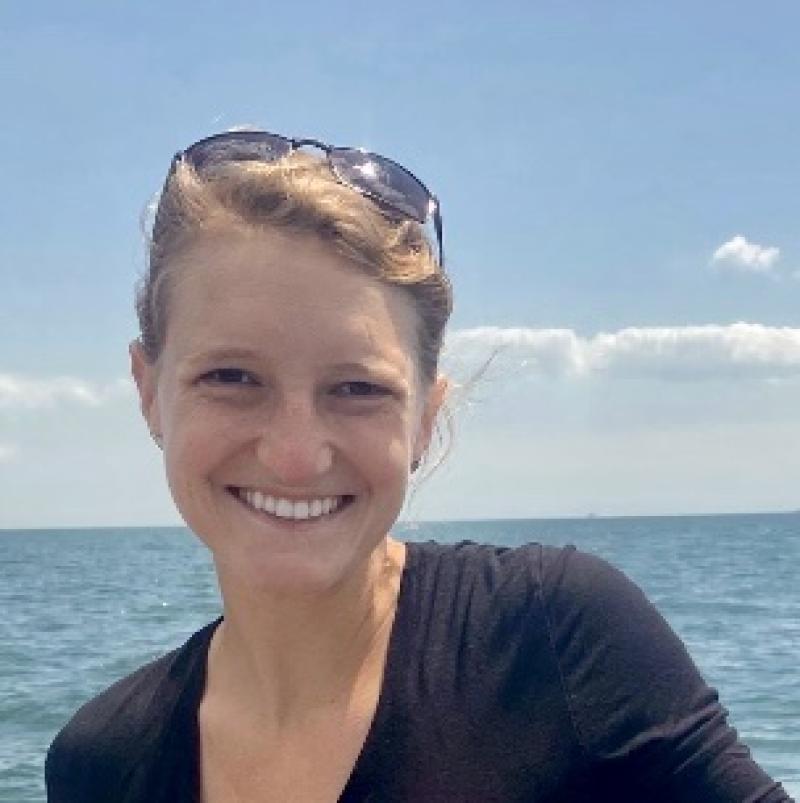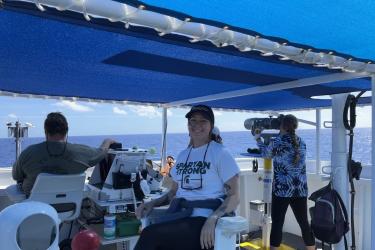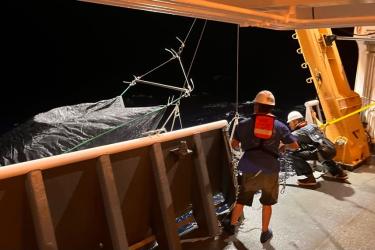One of the many tasks we have as marine ecologists at NOAA’s Pacific Islands Fisheries Science Center is to study fish that are important to the ecosystems and economy of Hawai‘i. How do they behave? What do they eat? How fast do they grow? Where do they spawn? These are just a few of the questions that scientists aim to better understand.
Our team recently set out to study the early life stage of several important fish species throughout Hawai‘i by focusing on baby fish, also called larvae. Larvae are difficult to study and we don’t know nearly as much about this early stage in their life cycles as we do about adult fish. To fill in this gap, we undertook an expansive larval fish survey that covered hundreds of miles of ocean. During a month-long journey at sea, our team of marine ecologists worked under the cover of darkness to collect plankton samples (communities of tiny creatures—including fish larvae—that drift along in the ocean) to better understand these baby fish. We focused on mahimahi (dolphinfish), ‘ahi (yellowfin and bigeye tuna), aku (skipjack tuna), ono (wahoo), a‘u (marlin), uku (green jobfish), uhu (parrotfish), and ‘ū‘u (menpachi/squirrelfish). Settle in and join us for a night in the life of a marine ecologist on the high seas!
Starting Our Day, Or Is It Night?
2:00 p.m. Aboard the NOAA Ship Oscar Elton Sette, we wake up and take some time for self care. We say “good morning” to folks, though for them it is midafternoon. Our colleagues, who are also aboard the Oscar Elton Sette, work during the day monitoring whales and dolphins as part of the Hawaiian Islands Cetacean and Ecosystem Assessment Survey.
4:50 p.m. Once we are ready to start our day, we head to the bow of the ship where we lead and welcome others to join us for an oli (Hawaiian chant). Prior to the start of our mission, we met with members of the Papahānaumokuākea Native Hawaiian Cultural Working Group and the Papahānaumokuākea Marine National Monument to learn and practice the oli, and to discuss the importance of incorporating Native Hawaiian practices when conducting our research throughout the islands. Our study is taking place throughout the full range of Kō Hawaiʻi Pae ʻĀina (Hawaiian Archipelago), including the monument. With the oli, we are taking a few moments to stop and be present in this special place, and humbly ask to be imparted with its knowledge.
5:00 p.m. What’s for dinner? Or, is it breakfast? The stewards (chefs) on board the Oscar Elton Sette are always making delicious meals to keep up morale and treat us to creative recipes every day. Although this should be breakfast for us, we start our day with delicious meals like pasta, curry, bao buns, kimchi fried rice, stuffed peppers, or whatever fun recipes the stewards have made for everyone. Or, sometimes we just reach for a quick treat if we’re in the mood for breakfast.
Operations Commence!
6:00 p.m. Operations meeting starts! We head up to the command center of the ship for a meeting with the evening crew. This meeting usually includes the chief scientist, NOAA Corps officers, deck crew, and us baby fish-studying marine ecologists. Our evening activities typically include towing plankton nets to collect fish larvae, and sampling water to collect eDNA. We discuss what the weather is like, how much time we will have to conduct our net tows, and who will be operating each piece of equipment.
6:30 p.m. Ensuring equipment is properly working and preparing sampling gear and data sheets is key to a successful night. We organize our processing equipment and freshen our samples by exchanging the ethanol from the previous day. Ethanol is used to preserve the precious plankton samples to keep them from rotting. The final preparation step is programming our temperature and depth recorders (TDRs) for the night’s operations. This lets us know what depth the net is towing through the water and how the temperature varies throughout the tow.
9:00 p.m. Deploy the nets and commence plankton tows! At the most basic level, we toss a net—called an Isaacs Kidd midwater trawl—over the side of the ship, drop the net to our depth of interest, and tow it alongside the ship for a set amount of time. Since the fish larvae we are interested in tend to be in fairly shallow waters at night, we would drop the net to roughly 164 feet before slowly hauling it back to the surface. We would continue to drop and lower the net to that depth several times in what we call a “to-yo” survey.
Despite the simplicity of the concept, there are a ton of steps that go into preparing the net and its associated sensors, the heavy machinery used to lift the net in and out of the water, and communication between scientists, deck crew, and NOAA Corps Officers driving the ship. It is a very detailed operation.
9:40 p.m. We haul the now wet and very heavy net back onto the deck to preserve whatever critters we caught. Once several to-yos are completed, the crew will hold the net at the side of the ship and slowly pull it in the rest of the way. One scientist guides a winged portion of the net back on board and the other pulls the rest of the net hand over hand into the ship, keeping the end of the net straight up and down. All of the plankton that we caught are now at the back of the net, so we want to treat it carefully.
Once the net is back on the deck, we use a salt water hose to spray it down and push any sticky critters toward the end of the net where a container called a cod end is located. We then pour its contents through a sieve to separate all the plankton from the seawater.
9:45 p.m. If time permits between tows, we separate some of the plankton into a tray for live sorting. This is our favorite part of the night! We place the tray on ice to keep everything fresh and cold. The rest of the sample is preserved in a jar with labels, including important information for us to refer back to when we want to connect this sample to environmental conditions.
10:00 p.m.–11:30 p.m. Time to get the net right back in the water for another tow. We repeat this process of tows and sample preservation as many times as possible before continuing the night’s transit.
11:45 p.m. For the rest of the night, we clean up, enter data into our online spreadsheets, and take photographs of interesting critters. By this point, we are either completely exhausted or jamming out to some fun beats in the wet lab as we explore our new plankton samples. Being out at sea for 30 days definitely causes our energy levels to fluctuate, but we wouldn't have it any other way!
Good Night and Good Morning
1:00 a.m. It’s now time to eat! The stewards are awesome and usually set some leftovers aside for our late night meals. It’s nice and quiet in the galley since we are usually some of the only people awake at this hour.
2:30 a.m. After dinner but before bed time: this time is ours. Oftentimes, we will catch up on our other work like data analysis from other projects, report writing, catching up on emails, etc. On weekends, we would often take this time to watch movies and eat ice cream, play video games, read books, or craft.
4:00 a.m. We now crawl into our bunk beds, fall asleep (or at least try to), and dream of larval fish. People often say they have the strangest dreams at sea! On the ship, we all sleep in rooms that may be shared between two people or up to 6 people depending on how many scientists are on board. The bunks are pretty comfortable and the rocking of the ship in calm seas makes for a good night’s sleep.
Until We Sea Each Other Again
Going to sea is one of the best parts of our job. It is essential to get away from our labs and computers and interact with the ocean ecosystems that we are studying. The whole experience breathes life into our data analysis and reporting efforts that we do the rest of the year. We may be short on sleep, but we are full of excitement about our findings. The variation of the plankton communities between sampling sites raised questions for us about how these creatures interact with the different environments across Kō Hawaiʻi Pae ʻĀina. Now that we are back on land, we’ll try to answer these and try our best to adjust to regular working hours. Until our next adventure, sea you soon!






